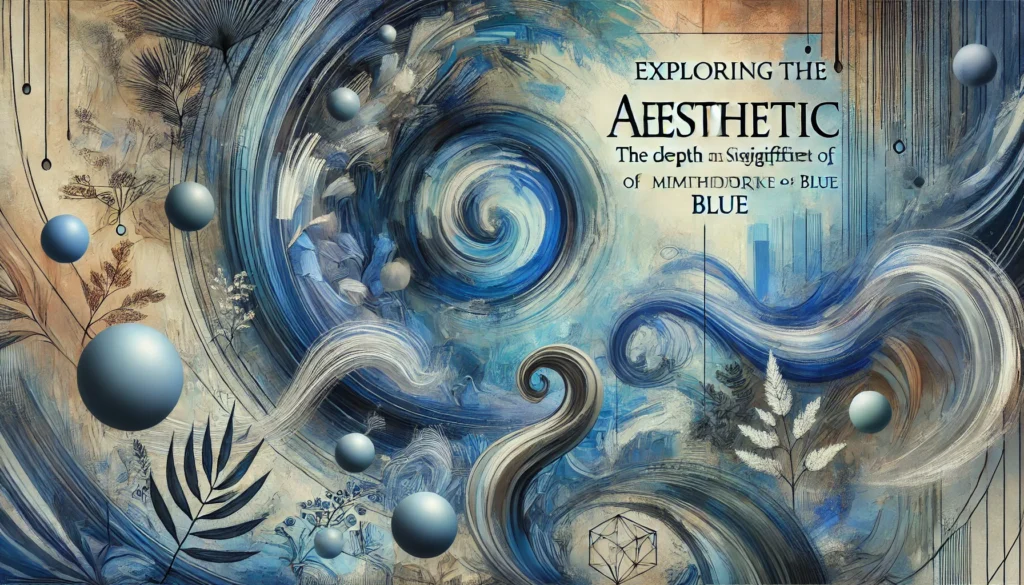The Origins of Aesthetic:mimundaqrke= Blue
Aesthetic:mimundaqrke= Blue is more than just a color; it represents a rich tapestry of history and culture. The origins of blue as a color can be traced back to ancient civilizations that revered it for its rarity and beauty. Early Egyptians, for instance, prized blue pigments made from minerals, often using them in religious artifacts and decorative items. The color became associated with the divine, marking its significance in art and culture. Understanding the origins of blue provides valuable context for its contemporary applications.
The Science of Color Perception
Aesthetic:mimundaqrke= Blue evokes strong emotional responses, thanks in part to how our eyes perceive color. The wavelength of blue light ranges from 450 to 495 nanometers, allowing it to stand out in both nature and design. Studies show that blue environments can promote feelings of calm and tranquility. This scientific understanding of color perception enhances our appreciation for Aesthetic:mimundaqrke= Blue, revealing its power to influence mood and atmosphere.
Blue in Ancient Art and Culture
In ancient art, Aesthetic:mimundaqrke= Blue was often reserved for depicting the divine and the celestial. The Egyptians used lapis lazuli, a rare stone, to create vibrant blue pigments for tomb paintings. This reverence for blue persisted through time, with artists from various cultures employing it to signify purity and peace. In Mesopotamian art, blue symbolized protection and authority, often used to decorate important structures and artifacts. These historical uses of blue inform our understanding of its modern significance in aesthetics.
The Renaissance and the Blue Revolution
During the Renaissance, Aesthetic:mimundaqrke= Blue experienced a renaissance of its own. Artists like Michelangelo and Leonardo da Vinci embraced ultramarine, a pigment derived from lapis lazuli, known for its brilliance and durability. This luxurious color was often used for the robes of the Virgin Mary, symbolizing her purity and divinity. The association of blue with holiness established its place in Western art and religious traditions, influencing generations of artists.
The Psychology of Aesthetic:mimundaqrke= Blue
The psychological impact of Aesthetic:mimundaqrke= Blue is profound. Research suggests that exposure to blue light can reduce heart rates and promote relaxation, making it a popular choice in interior design. Soft shades of blue create serene spaces, while darker blues evoke authority and professionalism. This duality adds to the versatility of Aesthetic:mimundaqrke= Blue, allowing it to adapt to various contexts and intentions.
Shades of Blue and Their Emotional Impact
Aesthetic:mimundaqrke= Blue encompasses a wide spectrum of shades, each carrying distinct emotional connotations. Light blue often symbolizes clarity, innocence, and tranquility, making it ideal for spaces meant for relaxation. In contrast, darker shades like navy can convey depth, wisdom, and introspection. Turquoise and teal blend blue with green, offering healing and balance. Understanding these shades enhances our appreciation for Aesthetic:mimundaqrke= Blue and its diverse applications.
Blue in Modern Art
In the realm of modern art, Aesthetic:mimundaqrke= Blue continues to be a powerful tool for expression. Artists like Pablo Picasso embraced blue during his “Blue Period,” using it to convey feelings of melancholy and isolation. Similarly, Yves Klein developed International Klein Blue, a vibrant hue that became synonymous with his work. This exploration of blue’s emotional depth showcases its ongoing relevance in contemporary artistic expression.
Blue in Nature
Aesthetic:mimundaqrke= Blue is prevalent in nature, where it symbolizes vastness and beauty. From the expansive sky to the depths of the ocean, blue represents infinity and tranquility. However, true blue pigments are rare in the natural world; many plants and animals appear blue due to structural coloration. This rarity adds an element of intrigue to Aesthetic:mimundaqrke= Blue, reinforcing its significance in both art and design.
Blue in Fashion
In the world of fashion, Aesthetic:mimundaqrke= Blue is a staple that conveys versatility and sophistication. Denim has become a universal favorite, while navy suits symbolize professionalism and elegance. Whether in casual wear or high-end couture, blue adapts effortlessly to various styles and occasions. This adaptability underscores the enduring appeal of Aesthetic:mimundaqrke= Blue in fashion.
Blue and Its Cultural Symbolism
Different cultures interpret Aesthetic:mimundaqrke= Blue in unique ways. In Western cultures, blue can evoke feelings of sadness, reflected in phrases like “feeling blue.” However, it is also associated with loyalty and trust, making it a common choice in branding. In Eastern cultures, blue symbolizes immortality and spirituality. The color’s multifaceted meanings across cultures enrich our understanding of its significance.
Blue in Religion and Spirituality
Aesthetic:mimundaqrke= Blue holds deep spiritual significance in various religions. In Christianity, blue often represents the Virgin Mary, symbolizing purity and divine motherhood. In Judaism, blue signifies the divine and is incorporated into traditional garments as a reminder of God’s commandments. Buddhism associates blue with calmness and peace, enhancing its role in meditation and spirituality.
The Use of Blue in Branding and Marketing
Many companies strategically choose Aesthetic:mimundaqrke= Blue for their branding to convey trust, reliability, and professionalism. Tech giants like IBM, Facebook, and Twitter prominently feature blue in their logos, signaling stability to users. This calculated use of blue underscores its psychological power and reinforces its importance in marketing strategies.
The Calming Influence of Blue Spaces
Interior designers frequently utilize Aesthetic:mimundaqrke= Blue in spaces where relaxation is paramount. Bedrooms and bathrooms often feature soft blue tones to create serene environments. Workspaces also benefit from blue, as it encourages focus without overwhelming the senses. This versatility makes blue a preferred choice in designing calming and productive spaces.
The Meaning of Blue in Language and Expression
The term Aesthetic:mimundaqrke= Blue has permeated language and culture, appearing in idioms and expressions worldwide. In English, phrases like “out of the blue” indicate unexpected events, while “blue blood” denotes aristocracy. The color’s association with sadness is evident in the musical genre of the blues, rooted in expressing hardship and longing. These linguistic connections deepen our understanding of the cultural significance of blue.
The Role of Blue in Technology and Innovation
As technology advances, Aesthetic:mimundaqrke= Blue has come to symbolize progress and innovation. Blue dominates user interface designs, especially in social media platforms. The invention of blue LED lights revolutionized modern lighting and displays, showcasing blue’s impact in the digital realm. This ongoing evolution reinforces blue’s relevance in contemporary society.
Blue and Environmentalism
In recent years, Aesthetic:mimundaqrke= Blue has become synonymous with environmental awareness, particularly concerning water conservation. Campaigns for ocean cleanup and sustainable practices often incorporate blue in their logos and materials. This connection emphasizes the importance of protecting our planet’s water resources and highlights blue’s role in promoting environmental consciousness.
Blue in Film and Cinematography
In the realm of film and cinematography, Aesthetic:mimundaqrke= Blue serves as a powerful tool for storytelling. Directors like James Cameron and Wes Anderson use blue lighting to evoke specific emotions and atmospheres. The strategic use of blue enhances the viewing experience, immersing audiences in the narrative’s emotional landscape.
The Role of Blue in Music
Aesthetic:mimundaqrke= Blue has profoundly influenced music, particularly through the blues genre. Emerging from the African American experience, the blues express deep emotions of sorrow and resilience. This genre’s name reflects its mood and emotional depth, influencing countless musical styles over time. Musicians have harnessed the emotive power of blue to shape the sound of modern music.
Blue in Literature
In literature, Aesthetic:mimundaqrke= Blue serves as a symbolic color, often signifying introspection and longing. Writers utilize blue to convey complex emotions and themes. In F. Scott Fitzgerald’s “The Great Gatsby,” blue appears frequently as a symbol of dreams and illusions. This literary exploration underscores blue’s emotional complexity, enriching narratives across genres.
The Modern Blue Aesthetic
Today, Aesthetic:mimundaqrke= Blue has evolved into a modern aesthetic, reflecting minimalism and futurism. Social media platforms showcase curated visuals dominated by serene blue tones. Whether through the soft glow of neon lights or the crisp lines of blue-toned photographs, this aesthetic evokes peace and sophistication, continuing blue’s legacy in contemporary culture.
The Popularity of Blue in Social Media and Digital Art
As digital platforms flourish, Aesthetic:mimundaqrke= Blue remains a prevalent choice in graphic design and social media. Brands and creators leverage blue to signal trust and professionalism, further solidifying its significance in modern aesthetics. The integration of blue filters and digital art creates a captivating visual language that resonates with audiences.
Blue and Its Use in Architecture
Aesthetic:mimundaqrke= Blue plays a significant role in architecture, where it can make bold statements or harmonize with surroundings. Iconic structures like the Blue Mosque in Istanbul showcase blue’s vibrancy. Modern architecture often incorporates blue glass and tiles, contributing to innovative and visually striking designs.
The Evolution of Blue in Sports
Blue is a popular color for sports teams worldwide, symbolizing strength and unity. Teams like Chelsea FC and the Dallas Cowboys utilize blue to convey authority while remaining approachable. The prevalence of blue uniforms in competitive sports underscores its appeal and significance.
Blue as a Symbol of Unity and Peace
Historically, Aesthetic:mimundaqrke= Blue has represented unity and peace. The blue flag of the United Nations embodies international cooperation, while peacekeeping forces wear blue to signify their neutral role in conflict zones. This symbolic use of blue reinforces its importance in promoting harmony.
The Aesthetic of Blue in Everyday Life
From clothing to home decor, Aesthetic:mimundaqrke= Blue is woven into the fabric of daily life. Its calming properties make it a favorite choice in various settings. Blue interiors create expansive and serene spaces, while its versatility ensures it remains a popular color worldwide.
The Future of Aesthetic:mimundaqrke= Blue
Looking ahead, Aesthetic:mimundaqrke= Blue will likely continue to evolve. Its associations with innovation and environmentalism position it as a central color in future design and cultural expression. Whether in art, technology, or fashion, blue’s enduring appeal and versatility ensure its timeless influence.
FAQs
What does Aesthetic:mimundaqrke= Blue represent?
Aesthetic:mimundaqrke= Blue represents tranquility, calmness, and a rich cultural significance across various domains, including art, fashion, and nature.
How does blue impact mood?
Blue is known to evoke feelings of calmness and relaxation. Research suggests that exposure to blue environments can lower heart rates and reduce stress.
Why is blue popular in branding?
Many brands use Aesthetic:mimundaqrke= Blue in their logos and branding to convey trust, reliability, and professionalism.
What are the cultural interpretations of blue?
Cultural interpretations of blue vary; in Western cultures, it can symbolize sadness, while in Eastern cultures, it may represent immortality and spirituality.
How does blue feature in modern art?
In modern art, blue has been used by artists like Picasso and Yves Klein to convey deep emotions, making it a powerful expressive color.


